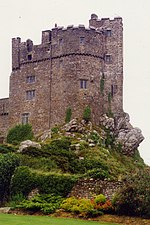Pembrokeshire Coast National Park
Coast of PembrokeshireGeography of PembrokeshireIUCN Category VNational parks in WalesNature reserves in Pembrokeshire ... and 2 more
Protected areas established in 1952Tourist attractions in Pembrokeshire

Pembrokeshire Coast National Park (Welsh: Parc Cenedlaethol Arfordir Penfro) is a national park along the Pembrokeshire coast in west Wales. It was established as a National Park in 1952. It is one of the three National parks of Wales, the others being the Brecon Beacons (Bannau Brycheiniog) and Snowdonia (Eryri). It is the only national park in the United Kingdom to consist largely of coastal landscapes.
Excerpt from the Wikipedia article Pembrokeshire Coast National Park (License: CC BY-SA 3.0, Authors, Images).Pembrokeshire Coast National Park
Folkeston Road,
Geographical coordinates (GPS) Address Nearby Places Show on map
Geographical coordinates (GPS)
| Latitude | Longitude |
|---|---|
| N 51.833333333333 ° | E -5.0833333333333 ° |
Address
Hilton Court Garden
Folkeston Road
SA62 3NL , Nolton and Roch
Wales, United Kingdom
Open on Google Maps








